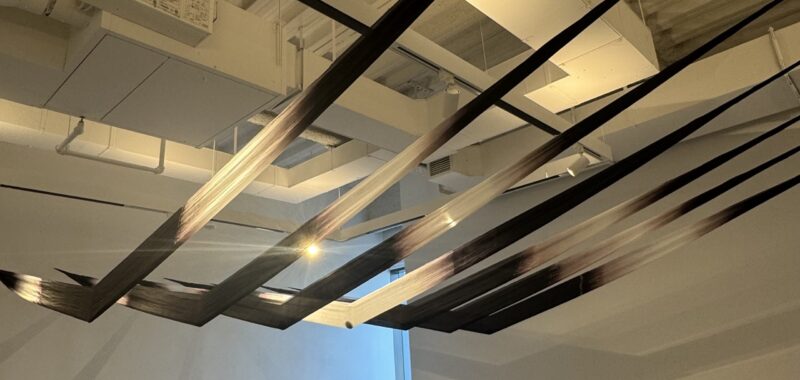In the second part of Pratt College’s MFA Fine Arts Thesis exhibition at its new Brooklyn Navy Yard satellite space, Mouet surprises viewers with a warped canvas. The plywood and poplar structure can be flexible, but also hold this unorthodox shape, subverting the convention of the flat canvas, as well as mirroring the distortedness of our current media, political, and economic climate.
Indeed, curator Dejá Aaliyah Belardo was struck by how many graduates were deploying spatial anomalies to critique the current moment. With the title Inside/Out, Belardo asks us to consider how ruptures in space can unlock novel metaphors for the abject moral environment of 2025.


In a painting installation within an alcove overlooking the Brooklyn Navy Yard, Zakariya Abdul-Qadir offers a portrait of Mahmoud Khalil, who was detained without a warrant by the United States Department of Homeland Security in retaliation for his activism at Columbia University, a right supposedly protected by the First Amendment. Abul-Qadir paints a crying Khalil in broad strokes of oil paint on transparent Dura-Lar, challenging viewers to feel his pain. Positioned within a window, the Brooklyn Navy Yard’s ship-like edifice seems to become part of the portrait, alluding to the intrusion of the military-industrial complex into Kahlil’s life and dignity. “I wanted to make a portrait of Kahil because of my own fear of losing speech,” Abul-Qadir explained to Hyperallergic.

Morgan Petitpas overtakes the gallery space with an installation of fabric, string, found objects, wire, and embroidered journal entries from different moments in her Pratt MFA journey in “Momento Memorials” (2025). “I’m not the only queer 30-year-old in New York looking for excitement, love and money,” she deadpanned to Hyperallergic, about the content of her journal entries, which spiral out and encroach upon the space. It’s a gentle spatial reminder to viewers that their subjectivity always colors what they perceive.

The lines in Leda Tsoutreli’s abstract paintings problematize their own construction of space, zigzagging through the picture plane. As she explained, “I am trying to understand the function of the canvas … as well as playing with its two-dimensionality.” Tsoutreli’s lines spill out, change direction, and even disrupt spatial dynamics she previously established. She often extends lines past the point when the brush runs out of paint, showcasing the pigment’s depletion, generating unorthodox painterly spaces and subverting what a line can be.

Shivani Mithbaokar likewise plays with lines and space in her found object piece, “There’s an Ocean within you” (2025), in which threads are glued onto a table to resemble veins that extend into the gallery floor. The artist’s intention with these veins is to cast the gallery space as a body where energy circulates like blood along a healing pathway. The larger installation features works composed of fragments of found wallpaper, a saree, and more thread-like veins to reveal interconnections in this environment, and interrupt the sterility of the white cube space.

Dana-Marie Bullock portrays herself as dead in a mixed media sculpture placed within a mahogany casket in “Tod und Verklärung (Death and Transfiguration)” (2025). As Bullock explained, “I wanted to talk about generational trauma and loss through my own experience and my own body.” The work contains several links to Jamaican mythology. For example, John Crow beads surround the coffin. The seeds are highly toxic in their raw form in the wild but can become healing when boiled and properly prepared. Bullock wanted to approach this feeling of death as a Black woman living in a hegemony that devalues her life, but also gesture towards an Indigenous magical tradition that is a source of healing.
In “Grounding Practice” (2025), Danielle Gadus suspends long swaths of silk from the gallery walls, each band weighed down by a river stone strategically positioned to stretch it into taut geometric hard edges. In the space, the silk casts strident geometric shadows against the wall. It’s a subtle and dynamic reimagining of space that plays between soft and hard.

“The space and time that I inhabit are always surrounded by indeterminate horizons that contain other points of view,” theorist Maurice Merleau-Ponty once wrote. The spatial fissures in the work of Pratt’s 2025 MFA graduate students resonate in what feels like an increasingly disjointive time. By challenging viewers’ perception of space to gesture towards these indeterminate horizons, these artists open up a new view to think through these perilous times.









Show 2: Inside Out, the second part of the 2025 Pratt MFA Fine Arts Thesis show Dock 72 building continues at Dock 72 (1 Dock 72 Way) at the Brooklyn Navy Yard through May 9th. The exhibition was curated by Dejá Aaliyah Belardo.

